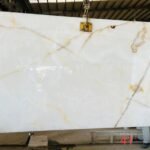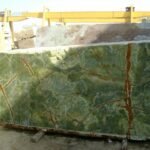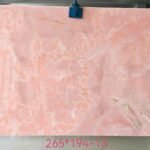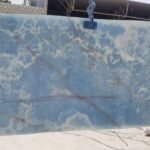Lapis Lazuli Countertops
Lapis lazuli countertops would be an exceptionally unique and luxurious choice for kitchen or bathroom surfaces. Lapis lazuli is a semi-precious stone with a captivating deep blue color, often accented by golden pyrite flecks, making it an exquisite material for decorative purposes. However, there are a few important considerations to keep in mind if you are interested in using lapis lazuli as a countertop material:
Rarity and Cost: Lapis lazuli is a rare and valuable stone, and as such, using it for countertops can be quite expensive. It is considered one of the more costly semi-precious stones, so be prepared for a significant investment if you choose this material.
Porosity and Sealing: Lapis lazuli is not as hard as some other natural stones used for countertops, like granite or quartzite. It is a relatively softer stone and can be more porous. Without proper sealing, it could be susceptible to stains and damage from acidic substances, so regular sealing and maintenance would be necessary.
Limited Availability: Due to its rarity, finding lapis lazuli slabs large enough for countertops may be challenging. You might need to work with specialized artisans or suppliers who can source and craft custom lapis lazuli countertops for your specific requirements.
Fragility: Lapis lazuli, while beautiful, is not as durable as harder stones commonly used for countertops. It can be more prone to chipping or cracking if subjected to heavy impact or pressure. Careful handling and installation by skilled professionals are crucial to ensure its longevity.
Design and Aesthetics: Lapis lazuli’s striking blue color can create a breathtaking visual impact in your space. However, its bold appearance might not fit all design styles or color schemes. Consider the overall aesthetics and design of your kitchen or bathroom to ensure that lapis lazuli complements the rest of the elements.
Alternative Options: If the cost and practicality of using lapis lazuli as countertops are prohibitive, you might consider alternative options. For instance, you could incorporate lapis lazuli into smaller decorative elements or art pieces within your kitchen or bathroom, such as mosaic tiles, backsplashes, or accents.
Before deciding on lapis lazuli countertops, it’s essential to conduct thorough research, consult with professionals, and consider your budget and lifestyle to determine if it’s the right choice for your needs and preferences. If you decide to proceed, working with experienced craftsmen who understand the unique properties of lapis lazuli is vital to ensure a stunning and long-lasting result.
Physical Properties of Lapis Lazuli
Classification A metamorphic rock that contains enough of the mineral lazurite to impart a distinct blue color. It may also contain significant amounts of calcite, pyrite, and minor amounts of other minerals.
Color Blue. Often with white calcite veining or mottling, and gold grains of pyrite.
Streak Blue.
Luster Dull, but polishes to a bright luster.
Diaphaneity Semi-translucent to opaque.
Cleavage None, though it may split easily along foliation or calcite veins and layers.
Mohs Hardness Varies between the 3 of calcite and the 5 to 5.5 of lazurite. Not well suited for use as a ring stone or in bracelets.
Specific Gravity 2.7 to 2.9 or more depending upon the amount of pyrite
Diagnostic Properties Blue color, association with pyrite, and hardness.
Uses Cabochons, beads, carvings, spheres, inlay, and pigments.




















